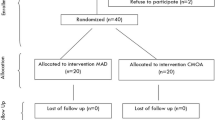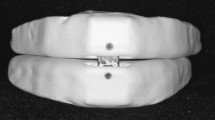Abstract
Background:
Mandibular protrusive appliances have long been used to treat obstructive sleep apnea/hypopnea syndrome (OSAHS). Their efficacy regarding respiration during sleep varies greatly and remains difficult to predict. In this study the efficacy of a two-splint appliance on nocturnal breathing disorders, sleep profile, and daytime sleepiness were evaluated according to a specially-designed treatment process.
Patients and Methods:
In this study 42 consecutive OSAHS patients who had been fitted with a mandibular protrusive appliance according to a preset treatment regimen were included in a follow-up analysis. The diagnosis and the degree of severity of OSHAS were determined by polysomnography in the sleep laboratory. The treatment regimen was established with the sleep laboratory physician. Treatment regimen included the diagnostic procedure in the sleep laboratory, each patient’s dental requirements, the fabrication of the appliance used, and the titration of the mandibular protrusion. After having grown accustomed to the appliance for 24.5 ± 7.8 days, 34 patients underwent overnight polysomnography.
Results:
The mean apnea/hypopnea index decreased significantly from 19.6 ± 12.8 to 3.3 ± 7.8 events per hour to 83%; the apnea index also improved significantly, as did minimal oxygen saturation and the desaturation index. Changes in sleep profile did not reach statistical significance; the arousal index (p < 0.02) and the subjectively-assessed daytime sleepiness (p < 0.02) decreased significantly. A therapeutically-required AHI of below 5 events per hour was achieved in 88.2% of the patients.
Conclusion:
A significant improvement in the respiratory situation of the vast majority of OSAHS patients, particularly in their AHI, can be achieved when one applies the procedural steps and employs the mandibular protrusive appliance we describe herein.
Zusammenfassung
Hintergrund:
Intraorale Protrusionsapparaturen werden seit längerem zur Behandlung des obstruktiven Schlafapnoe-/Hypopnoesyndroms (OSAHS) verwendet. Der Effekt auf die respiratorische Situation im Schlaf variiert stark und kann bisher nur schwer vorhergesagt werden. In dieser Untersuchung wurde die Effektivität eines gesondert formulierten Behandlungskonzeptes unter der Anwendung einer Zweischienenapparatur auf die nächtliche Atemstörung, das Schlafprofil und die Tagesschläfrigkeit geprüft.
Patienten und Methoden:
Es wurden konsekutiv 42 Patienten mit der polysomnographisch gestellten Diagnose eines OSAHS, die mit einer intraoralen Protrusionsapparatur nach einem zuvor zusammen mit dem Mediziner aus dem Schlaflabor festgelegten Behandlungsprozess versorgt wurden, in die Studie eingeschlossen. Der Behandlungsprozess umfasste die Diagnosestellung im Schlaflabor, die zahnärztlichen Voraussetzungen, die Herstellung der verwendeten Apparatur und die Einstellung der Unterkiefersperrung. Nach einer Eingewöhnungsphase von 24,5 ± 7,8 Tagen wurden 34 Patienten schlafmedizinisch nachkontrolliert.
Ergebnisse:
Der durchschnittliche Apnoe-Hypopnoe-Index (AHI) nahm signifikant von 19,6 ± 12,8/Std. auf 3,3 ± 7,8/Std. um 83% ab; ebenso verbesserten sich der Apnoe-Index, die minimale Sauerstoffsättigung und der Entsättigungsindex statistisch signifikant. Im Schlafprofil wurden im Vergleich zum Ausgangswert statistisch keine Änderungen festgestellt; der Arousal-Index (p < 0,02) und die subjektiv beurteilte Tagesschläfrigkeit (p < 0,02) änderten sich signifikant. Bei 88,2% der Patienten wurde ein therapeutisch geforderter AHI unter 5/Std. erzielt.
Schlussfolgerungen:
Unter der Anwendung der eingeführten Prozessparameter kann bei der überwiegenden Mehrzahl der OSAHS-Patienten mit der verwendeten Unterkieferprotrusionsapparatur eine signifikante Verbesserung der respiratorischen Situation, insbesondere des AHI, erreicht werden.
Similar content being viewed by others
Author information
Authors and Affiliations
Corresponding author
Additional information
English version revised by Carol Cürten, Freiburg/Br.
Rights and permissions
About this article
Cite this article
Rose, E.C., Germann, M., Sorichter, S. et al. Case Control Study in the Treatment of Obstructive Sleep-Disordered Breathing with a Mandibular Protrusive Appliance. J Orofac Orthop 65, 489–500 (2004). https://doi.org/10.1007/s00056-004-0423-y
Received:
Accepted:
Issue Date:
DOI: https://doi.org/10.1007/s00056-004-0423-y




